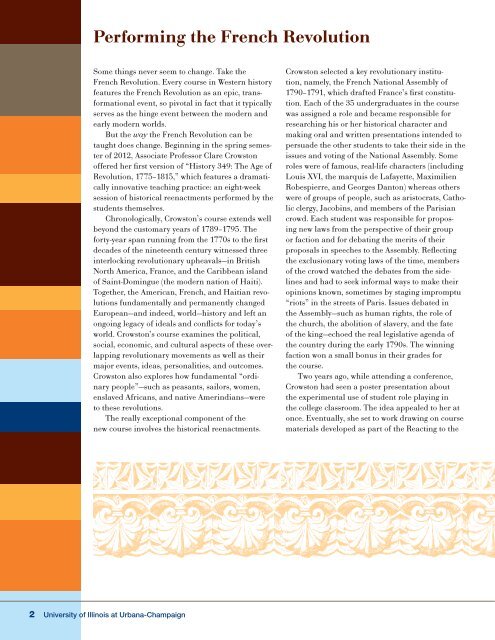Spring 2013 - History - University of Illinois at Urbana-Champaign
Spring 2013 - History - University of Illinois at Urbana-Champaign
Spring 2013 - History - University of Illinois at Urbana-Champaign
You also want an ePaper? Increase the reach of your titles
YUMPU automatically turns print PDFs into web optimized ePapers that Google loves.
Performing the French RevolutionSome things never seem to change. Take theFrench Revolution. Every course in Western historyfe<strong>at</strong>ures the French Revolution as an epic, transform<strong>at</strong>ionalevent, so pivotal in fact th<strong>at</strong> it typicallyserves as the hinge event between the modern andearly modern worlds.But the way the French Revolution can betaught does change. Beginning in the spring semester<strong>of</strong> 2012, Associ<strong>at</strong>e Pr<strong>of</strong>essor Clare Crowston<strong>of</strong>fered her first version <strong>of</strong> “<strong>History</strong> 349: The Age <strong>of</strong>Revolution, 1775–1815,” which fe<strong>at</strong>ures a dram<strong>at</strong>icallyinnov<strong>at</strong>ive teaching practice: an eight-weeksession <strong>of</strong> historical reenactments performed by thestudents themselves.Chronologically, Crowston’s course extends wellbeyond the customary years <strong>of</strong> 1789–1795. Theforty-year span running from the 1770s to the firstdecades <strong>of</strong> the nineteenth century witnessed threeinterlocking revolutionary upheavals—in BritishNorth America, France, and the Caribbean island<strong>of</strong> Saint-Domingue (the modern n<strong>at</strong>ion <strong>of</strong> Haiti).Together, the American, French, and Haitian revolutionsfundamentally and permanently changedEuropean—and indeed, world—history and left anongoing legacy <strong>of</strong> ideals and conflicts for today’sworld. Crowston’s course examines the political,social, economic, and cultural aspects <strong>of</strong> these overlappingrevolutionary movements as well as theirmajor events, ideas, personalities, and outcomes.Crowston also explores how fundamental “ordinarypeople”—such as peasants, sailors, women,enslaved Africans, and n<strong>at</strong>ive Amerindians—wereto these revolutions.The really exceptional component <strong>of</strong> thenew course involves the historical reenactments.Crowston selected a key revolutionary institution,namely, the French N<strong>at</strong>ional Assembly <strong>of</strong>1790–1791, which drafted France’s first constitution.Each <strong>of</strong> the 35 undergradu<strong>at</strong>es in the coursewas assigned a role and became responsible forresearching his or her historical character andmaking oral and written present<strong>at</strong>ions intended topersuade the other students to take their side in theissues and voting <strong>of</strong> the N<strong>at</strong>ional Assembly. Someroles were <strong>of</strong> famous, real-life characters (includingLouis XVI, the marquis de Lafayette, MaximilienRobespierre, and Georges Danton) whereas otherswere <strong>of</strong> groups <strong>of</strong> people, such as aristocr<strong>at</strong>s, C<strong>at</strong>holicclergy, Jacobins, and members <strong>of</strong> the Parisiancrowd. Each student was responsible for proposingnew laws from the perspective <strong>of</strong> their groupor faction and for deb<strong>at</strong>ing the merits <strong>of</strong> theirproposals in speeches to the Assembly. Reflectingthe exclusionary voting laws <strong>of</strong> the time, members<strong>of</strong> the crowd w<strong>at</strong>ched the deb<strong>at</strong>es from the sidelinesand had to seek informal ways to make theiropinions known, sometimes by staging impromptu“riots” in the streets <strong>of</strong> Paris. Issues deb<strong>at</strong>ed inthe Assembly—such as human rights, the role <strong>of</strong>the church, the abolition <strong>of</strong> slavery, and the f<strong>at</strong>e<strong>of</strong> the king—echoed the real legisl<strong>at</strong>ive agenda <strong>of</strong>the country during the early 1790s. The winningfaction won a small bonus in their grades forthe course.Two years ago, while <strong>at</strong>tending a conference,Crowston had seen a poster present<strong>at</strong>ion aboutthe experimental use <strong>of</strong> student role playing inthe college classroom. The idea appealed to her <strong>at</strong>once. Eventually, she set to work drawing on coursem<strong>at</strong>erials developed as part <strong>of</strong> the Reacting to the2 <strong>University</strong> <strong>of</strong> <strong>Illinois</strong> <strong>at</strong> <strong>Urbana</strong>-<strong>Champaign</strong>


